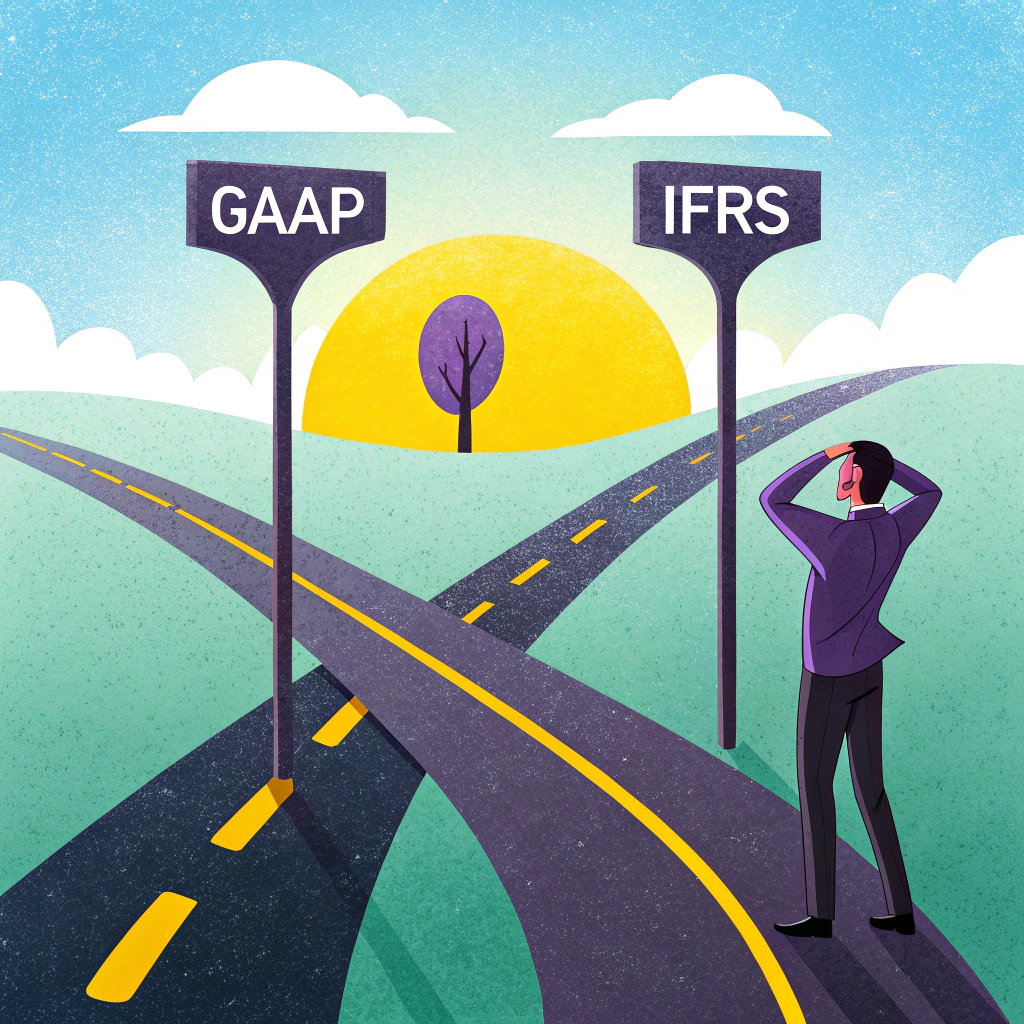Alright, let’s cut to the chase: What’s the real deal with GAAP vs IFRS balance sheets, and why should you even care? If you’ve ever felt like accountants are speaking a different language, you’re not alone. But stick with me here—understanding these two heavyweights in the accounting world can be the difference between your business soaring or, well, face-planting financially.
So, GAAP and IFRS are like the Batman and Superman of accounting standards—both heroes in their own right but with different approaches to fighting crime (or in this case, financial discrepancies). Generally, accounting standards make sure a company’s financial statements are accurate and comparable—so we’re all playing the same game and not comparing apples to, say, unicorns.
But here’s the kicker: when it comes to preparing a balance sheet—that all-important snapshot of your company’s financial health—deciding which set of standards to follow isn’t just a matter of flipping a coin. It depends on whether you’re operating in the U.S. or taking your business global, because there are some significant differences between the two. Think of it like driving on the right side of the road versus the left—same destination, different routes.
So, what’s GAAP and what’s IFRS, besides sounding like noises you make when sneezing? GAAP stands for Generally Accepted Accounting Principles, and it’s the rulebook laid out by the Financial Accounting Standards Board (FASB). It’s the go-to guide for most U.S. companies. IFRS, on the other hand, is the International Financial Reporting Standards, dictated by the globe-trotting folks at the International Accounting Standards Board (IASB), and it’s used by companies in many countries outside the U.S.
Here’s a fun fact: GAAP is big on rules—think of it as the strict teacher who won’t let you chew gum in class. IFRS is more about principles, like that cool professor who lets you eat pizza during lectures. In this article, we’re going to dive into the differences and similarities between GAAP vs IFRS balance sheets. But before we get into the nitty-gritty, let’s make sure we’re all on the same page about what a balance sheet actually is. Ready? Let’s roll!
Related: IFRS Recognition of Revenue
Balance Sheet Explained
Alright, let’s unravel the mystery of the balance sheet—also grandly known as the statement of financial position. Think of it as your company’s financial selfie, capturing everything at a specific moment in time. It shows a neat summary of your company’s assets, liabilities, and equity. Both GAAP and IFRS insist that companies present a balance sheet, along with other thrilling reports like the income statement and the cash flow statement.
So, your balance sheet is like the financial report card for your company at a specific point—no pressure! It typically comes in two columns: one for what you own (assets) and one for what you owe (liabilities and equity). Which brings us to the golden accounting equation:
Assets = Liabilities + Equity
This little equation is the backbone of accounting—everything your company owns must equal everything it owes plus what’s left over for the owners. If your balance sheet doesn’t balance, it’s like showing up to a party with mismatched socks—something’s definitely off. Business owners, accountants, investors, and those number-loving auditors use the balance sheet to keep tabs on a company’s financial health.
Under both IFRS and GAAP, the balance sheet isn’t optional—it’s as mandatory as paying taxes (unfortunately). It shows your company’s assets and liabilities at a specific point in time. Plus, both standards require those delightful footnotes that clarify and explain the data—think of them as the behind-the-scenes commentary that nobody reads but everyone needs. For example, the notes might explain the accounting methods used, which is crucial because let’s face it, companies can get creative with their accounting.
But here’s where things get spicy: preparing a balance sheet under GAAP vs IFRS isn’t just a matter of swapping labels—the format itself can differ significantly. In the U.S., GAAP dictates that current assets—the stuff you can quickly turn into cash—are listed first. IFRS flips the script, starting with non-current assets. It’s like reading a book from the end to the beginning—still the same story, but told differently. GAAP likes to list accounts in order of liquidity (most liquid to least), while IFRS does the exact opposite. It’s financial mirror worlds!
See also: GAAP for Revenue Recognition: Criteria and Examples
GAAP vs IFRS Balance Sheet Differences
So, what’s the fuss all about? Here are some of the key differences between GAAP and IFRS balance sheets that you should know:
- Asset Listing Order (liquidity Lineup): GAAP loves to showcase current assets first, the cash and stuff you can quickly turn into cash – GAAP arranges accounts from most liquid to least liquid. IFRS, on the other hand, starts with non-current assets. IFRS? It does the exact opposite, going from least liquid to most. It’s like GAAP serves appetizers before the main course, while IFRS goes straight for the steak.
- Inventory Reversal: Under GAAP, once you write down inventory, it’s a one-way ticket—no take-backs. IFRS is a bit more forgiving and allows inventory reversals under certain conditions. So if your unsold fidget spinners suddenly become all the rage again, IFRS lets you adjust.
- LIFO Inventory Method: GAAP permits the use of Last In, First Out (LIFO) for inventory accounting. IFRS says, “Nope, we don’t do that here.” So if you’re a fan of LIFO, better stick with GAAP.
- Liabilities Classification: Under GAAP, liabilities are neatly split into current and non-current. IFRS doesn’t bother with that segregation. It’s like GAAP is the neat freak organizing debts in separate drawers, while IFRS tosses them all into one big box.
Valuation of Fixed Assets
Now, let’s talk about valuing fixed assets—those big-ticket items like buildings, machinery, and even that fancy espresso machine in the break room. Both GAAP and IFRS agree that you recognize these assets when you buy them. But when it comes to valuing them over time, they part ways.
Under GAAP, fixed assets are measured at their initial cost. Think of it as a “set it and forget it” approach—the value can go down through depreciation or impairment, but it can’t go up. No love for appreciation here!
IFRS, however, is more flexible. It allows companies to revalue fixed assets to reflect fair market value. So if your office building suddenly skyrockets in value because they built a theme park next door, IFRS lets you capture that gain. Also, IFRS allows you to depreciate components separately—like the roof versus the HVAC system—while GAAP doesn’t require such detailed segregation.

Revaluation of Assets on the Balance Sheet
Let’s say an asset’s value takes a hit—maybe your state-of-the-art equipment becomes obsolete overnight (curse you, technology!). Under GAAP, once you write down an asset due to impairment, there’s no turning back. The value stays put, even if circumstances improve.
IFRS is more optimistic. It allows for the revaluation of assets back up to their original cost if the reasons for impairment no longer exist. So if your equipment suddenly becomes relevant again, you can adjust its value upward. GAAP, on the other hand, is like that grudge-holding friend—it doesn’t forget or forgive.
Recognition of Intangible Assets
When it comes to intangible assets—things like patents, trademarks, or that secret sauce recipe—GAAP and IFRS have different philosophies.
IFRS considers whether an asset will have future economic benefits to assess its value. GAAP, however, measures intangible assets at fair market value and that’s about it. So under GAAP, intangible assets must be reported at cost, while IFRS allows for revaluation to reflect changes in fair value. It’s like GAAP is stuck in the past, while IFRS is keeping up with the times.
Inventory Valuation Methods
Inventory valuation is a biggie when comparing GAAP vs IFRS balance sheets. Companies use methods like FIFO (First In, First Out), LIFO (Last In, First Out), and weighted average to value inventory.
Under GAAP, all these methods are fair game. You can choose whichever suits your financial palate. IFRS, however, says a big “nope” to LIFO. It only allows FIFO and weighted average methods. So if you’re a LIFO lover, you’re stuck with GAAP.
The Write-Down Difference
GAAP requires companies to write down the market value of their fixed or inventory assets if they decrease. Even if the asset’s market value increases later, you can’t reverse that write-down. IFRS is more accommodating—it allows the reversal of an asset’s value when its price increases. So under IFRS, you can reflect positive market changes, making your balance sheet more current.
Classification of Liabilities
Organizations can classify liabilities into current and non-current, depending on how soon they need to be paid. GAAP makes a clear distinction between the two, listing current liabilities first. IFRS doesn’t sweat the small stuff and doesn’t require this segregation. So under IFRS, long-term liabilities might get top billing over short-term ones.
Listing Order of Assets
One of the key differences between GAAP vs IFRS balance sheets is the listing order of assets. Under GAAP, assets are listed in decreasing order of liquidity—cash is king and comes first. IFRS, however, arranges assets from least liquid to most liquid. It’s like GAAP is counting down, while IFRS is counting up.
Quarterly/Interim Reports
GAAP treats quarterly reports as an integral part of the fiscal year and requires a Management’s Discussion and Analysis (MD&A) section. IFRS considers each interim report as a standalone period and doesn’t require an MD&A (though it’s allowed). So if you love writing lengthy analyses every quarter, GAAP’s your guy!
Investment Property
Under GAAP, all property is lumped together in the Property, Plant, and Equipment (PP&E) category—no special treatment for investment properties. IFRS, however, allows companies to separate investment property—property held for capital appreciation or rental income—from PP&E. So if you’re into real estate investments, IFRS gives you more flexibility.
Lease Accounting
Both standards require leases longer than 12 months to be reported on the balance sheet as Right of Use Assets. But GAAP distinguishes between Operating and Finance Leases, while IFRS does not. IFRS also has a de minimis exception for low-value assets, which GAAP lacks. So leasing under IFRS can be a bit more lenient.
Deferred Taxes
Under IFRS, deferred taxes are classified as non-current liabilities, and footnotes are required to explain the details. GAAP allows deferred taxes to be listed as both current and non-current liabilities and doesn’t have this footnote requirement. So GAAP offers more flexibility in classification but less transparency.

Table Summarizing the Differences
| Factors for comparison | GAAP | IFRS |
| Quarterly/Interim reports for balance sheet | The US GAAP considers each quarterly report as an integral part of the fiscal year and requires an MD&A section | IFRS considers each interim report as a standalone period, and even though an MD&A section is allowed, it is not required |
| Order of listing | GAAP requires accounts to be listed in the order of liquidity based on how quickly and easily they can be converted to cash (that is, accounts are listed from most liquid to least liquid | Under IFRS, the order of listing is in ascending order of liquidity (that is, accounts are listed from the least liquid to the most liquid). |
| Arrangement of accounts | The balance sheet is arranged in the order of current assets, non-current assets, current liabilities, non-current liabilities, and owner’s equity | The balance sheet is arranged in the order of non-current assets, current assets, owners’ equity, non-current liabilities, and current liabilities |
| Considering a contingent liability probable | When the likelihood is >75% | When the likelihood is >50% |
| Investment property category | Under GAAP, all properties are included in the general category of Property, Plant, and Equipment (PP&E) and do not have an investment property category | Under IFRS, the Investment property category is allowed on the balance sheet for property held for capital appreciation or rental income |
| Allowed inventory valuation methods | GAAP allows the use of FIFO, LIFO, and weighted inventory methods for inventory valuation | IFRS allows only FIFO and weighted average methods to be used for inventory valuation and doesn’t permit the use of LIFO |
| Valuation of Property, Plant, and Equipment (Tangible fixed assets) | For fixed asset valuation, GAAP does not allow the use of a revaluation model but allows the use of a cost model | For fixed asset valuation, IFRS allows either the cost model or the revaluation model |
| Inventory Reversal | GAAP prohibits inventory write-down reversal | IFRS permits inventory write-down reversal if specified conditions are met |
| Deferred Taxes | Under GAAP, deferred taxes are allowed to be listed as both current and noncurrent liabilities and does not have a footnote requirement | Under IFRS, deferred taxes are classified as noncurrent liabilities and footnotes are required |
Check out: IFRS vs GAAP Income Statement: Differences and Similarities
GAAP vs IFRS Balance Sheet Similarities
It’s not all differences and discrepancies. GAAP and IFRS do share some common ground:
- Both require the presentation of balance sheets, statements of cash flows, and income statements.
- They both agree on how cash and cash equivalents are dealt with on the balance sheet.
- Both allow the use of the FIFO and weighted average-cost methods for inventory valuation.
- Under both standards, leases greater than 12 months are reported on the balance sheet as Right of Use Assets.
- Fixed assets are depreciated over their expected useful lives under both GAAP and IFRS.
